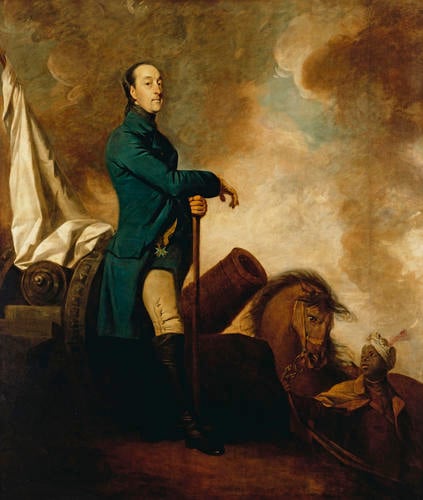-
1 of 253523 objects
Frederick William Ernest, Count of Schaumburg-Lippe (1724-77) and a Groom c.1767
Oil on canvas | 245.4 x 206.7 cm (support, canvas/panel/stretcher external) | RCIN 405893

Sir Joshua Reynolds (1723-92)
Frederick William Ernest, Count of Schaumburg-Lippe (1724-77) c.1767
-
Deploying a low perspective to emphasise the heroic monumentality of his subject, Reynolds sets his subject in silhouette against the smoke-filled skies of the ongoing action. Dressed in a dark blue uniform with the riband of the Black Eagle of Prussia, Schaumburg-Lippe was Commander of Artillery under the allied forces of Prince Ferdinand of Brunswick during the Seven Years’ War.
Paired with a portrait of John Manners, Marquess of Granby (1721-70), Commander-in-Chief of the British forces (RCIN 405894), this work was commissioned by George Townshend, 1st Marquess Townshend (1724-1807), who served under both men during the conflict.
Many free and enslaved Black men served the British army during the Seven Years’ War. The groom holding Schaumburg-Lippe’s bay horse is currently unidentified, but the figure is depicted wearing a silver collar, which demonstrates that they are enslaved. If modelled on a real person, their identity is now unknown. During the eighteenth century, attendants of African descent often featured within portraits of European sitters as a visual trope to convey the wealth and status of the European sitter.
As the leading portraitist of the age, Reynolds gained recognition under George III, receiving a knighthood, being appointed the first president of the Royal Academy and Principal Painter to the King upon Ramsay’s death in 1784. Despite this, he never received a commission. The fact that the Royal Collection holds a significant group of paintings by this leading eighteenth-century portraitist is entirely thanks to the patronage and collecting of George IV.
The work was presented to George IV by Townshend’s widow in 1810. It hung in the Crimson Drawing Room at Carlton House, George IV’s residence on Pall Mall, before being transferred to St James’s Palace in 1830.
Provenance
One of a pair (RCIN 405893-4) presented to George IV by Lady Townsend in 1810; recorded hanging in the Crimson Drawing Room at Carlton House in 1819 (no 8); sent to St James's Palace in 1830
-
Medium and techniques
Oil on canvas
Measurements
245.4 x 206.7 cm (support, canvas/panel/stretcher external)
285.0 x 249.5 x 17.0 cm (frame, external)
Category
Object type(s)
Other number(s)
Alternative title(s)
Friedrich Wilhelm Ernst, Count of Schaumburg-Lippe (1724-1777)
Count William of Lippe-Buckeburg, previously entitled